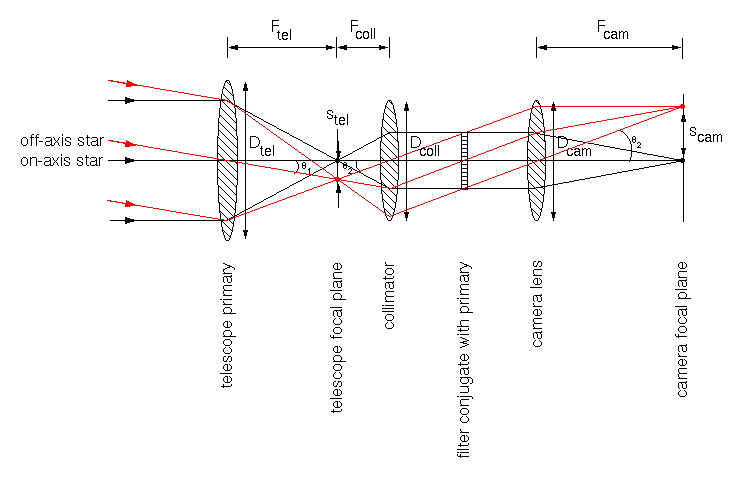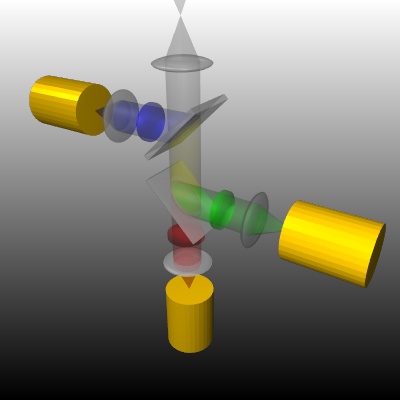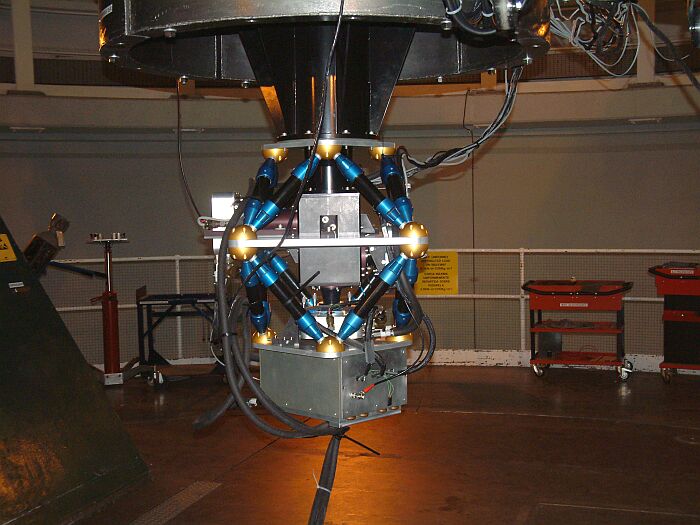| re-imagers |
|
Focal reducers and extenders are commonly found on amateur telescopes. On professional telescopes, however, a more complex way of changing the plate scale and field of view is usually employed. This method, which shall be referred to as a re-imager, is still a form of focal reducer/extender, but uses a collimator placed after the focal plane of the telescope to make the diverging beam parallel. (To do this, the collimator must be placed at a distance equal to its focal length from the focal plane). The parallel beam then passes through a filter before it is focused onto the detector by a camera lens. A schematic of a re-imager is shown in figure 72.
| figure 72: |
The light path of an on-axis and an off-axis star through a typical astronomical
re-imager. The plate scale at the camera focal plane is different to the
plate scale at the telescope focal plane due to the action of the collimator
and camera lens. Note the position of the filter, which is placed conjugate
with the telescope primary (see text for details). |

The optical layout shown in figure 72 is
similar to that of the telescope, eyepiece and eye system
shown in figure 27.
From Figure 72 it can be seen that the two
stars are separated by a distance stel =
Ftel ![]() 1 = Fcoll
1 = Fcoll ![]() 2 in the telescope focal
plane, and by a distance scam = Fcam
2 in the telescope focal
plane, and by a distance scam = Fcam
![]() 2 in the
camera focal plane. We can therefore define a magnification, M,
as follows:
2 in the
camera focal plane. We can therefore define a magnification, M,
as follows:
M = scam / stel.
With this definition, if our re-imager has M < 1 we have a focal
reducer (i.e. a demagnifier), and if M > 1 we have a focal
extender (i.e. a magnifier). We can now derive a relation between
M and the focal lengths of the collimator and camera
lenses, as follows:
M = Fcam
![]() 2 /
Fcoll
2 /
Fcoll ![]() 2 =
Fcam / Fcoll.
2 =
Fcam / Fcoll.
Hence, the magnification is given by the ratio of the camera to
collimator focal lengths. This is an important equation, of use not
only for re-imagers but also for spectrographs. A demonstration of when
this equation is useful is given in the example problems.
Re-imagers have a number of advantages over the simple focal reducers/extenders shown in figure 71. First, since the filter is placed in a parallel beam, there is no change of focus if filters of different optical thickness are used, and no optical aberrations are introduced. Second, the filter can be positioned so that all of the rays incident on the primary mirror pass through the filter, i.e. the filter is said to be conjugate with the primary (and coincident with the so-called pupil image), as shown in figure 72. The advantage of this is that the minimum-sized (and hence cheapest) filter is then required to collect light from all angles. A circular aperture, or stop, is also often placed at this position in order to reject stray light from the system. Third, the collimated beam is optically easier to control than a diverging/converging beam, and hence it is more straightforward to provide space for additional optics, e.g. for adaptive optics or simultaneous multi-colour imaging (see figure 73).
| figure 73: |
Left: A schematic ray-trace through ULTRACAM, the
Sheffield/Warwick/UKATC-built three-colour imager. Light from the
telescope focal plane at the top is collimated and then passes through
two dichroic beamsplitters. The first reflects just the blue light,
which then passes through a filter before being re-imaged by a camera
onto a CCD (the yellow cylinder). The second dichroic reflects just
the green light, leaving the red light to fall onto the CCD at the
bottom. Right: ULTRACAM mounted at the Cassegrain focus of the 4.2 m
William Herschel Telescope on La Palma.
|

